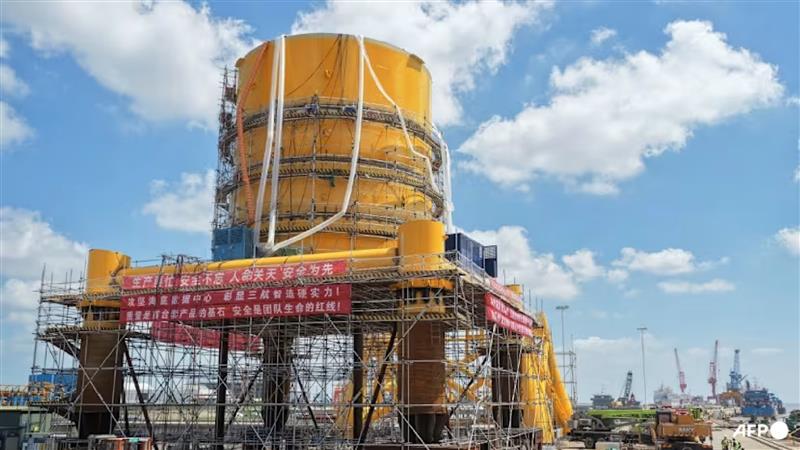 Credit: AFP
Credit: AFP On June 11, a China under water data center was launched as an underwater experiment off Shanghai, submerging a massive steel capsule to harness ocean cooling in a bold test of sustainable digital infrastructure to reduce energy consumption by 90%, according to Xhinua.
Powered by offshore wind and developed by China Telecom, among others, the state-backed project will complete redefine server cooling and resilience but still faces questions about its long-term environmental repercussions and scalability.
It is not only a matter of saving electricity but an experiment in relocating data infrastructure to a difficult environment, where submerged servers must withstand salt water, pressure, and isolation.
The ocean is not just a cooling system in the eyes of engineers, as it is perceived as a lab to create subsea sustainable and resilient infrastructure for future global networks.
Building Technology Under Sea Pressure
At a wharf near Shanghai, workers are testing a large steel capsule prior to it being shipped offshore. Designed as an underwater intelligent computing center, the capsule will serve China Telecom and a state-owned AI computing company and other likewise firms.
The electricity generated will be drawn from offshore wind firms, a step toward data center renewable energy integration.
“Underwater operations have inherent advantages,” said Yang Ye of maritime equipment firm Highlander. He is building the pod with state-owned partners.
Ocean streams replace costly data center cooling optimization on land.
Underwater facilities can save approximately 90% of energy consumption for cooling,” Yang, vice president of Highlander, told Agence France-Presse (AFP).
Highlander’s earlier pilot in Hainan province, subsidized by $5.62 million (40 million yuan), is currently running. By pursuing such projects, China is bridging underwater innovation with sustainable data center energy solutions to reduce reliance on conventional infrastructure.
Moreover, on an environmental level, opting for this option will end up decreasing data center carbon footprint.
Underwater Servers and Ecological Unknowns
Despite the continuation of the China underwater data center project, concerns persist.
Microsoft experimented with similar technology in waters off Scotland in 2018, but never commercially developed on it. However, experts are afraid that although subsea data center cooling solutions seem promising, scaling up will pose new dangers.
“The actual completion of the underwater data centre involved greater construction challenges than initially expected,” explained Shanghai project engineer Zhou Jun.
On the other hand, underwater servers cause environmental concerns.
Andrew Want, a marine ecologist at Hull University argue that the warming impact of a China underwater data center on the neighboring water has raised alarm regarding the impact on marine ecosystems. Because heat can attract some species and repel others, raising questions on digital sustainable economies based on marine ecosystems.
Many perceive the project as a contributor to carbon footprint reduction that uses seawater for natural cooling, but marine ecologists disagree – to some extent.
Marine ecologists warn that large-scale deployment of such projects could create thermal pollution, completely altering local marine ecosystems.
However, Highlander tests, that measure how submerging server pods affects water temperature, server performance, and structural resilience and the surrounding marine environment stays within safe limits before scaling up commercial deployments have proved surrounding water temperatures remain safe.
Still, Shaolei Ren from University of California, cautioned that larger projects could scale up thermal risks, saying that “for megawatt-scale data centres underwater, the thermal pollution problem needs to be studied more carefully.”
Looking at China, the initiative aligns with the overall sustainable energy data center solutions. Moreover, it serves China’s prevention of energy crisis strategy under the theme of renewable integration.
Although the China underwater data center is not to replace land-based centers completely, it symbolizes a turning point where offshore facilities are used to facilitate sustainable energy data center solutions. and map the next generation of cloud computing.
“They’re probably not going to replace existing traditional data centres, but can provide service to some niche segments,” Ren from UC Riverside said.
Experts and policymakers both see this project less as a solution and more as an open-ended experiment. By immersing servers in the water, China is attempting, essentially, to test the limits of how much digital infrastructure can handle a changing world.
In the end, the fate of this project could influence how future China underwater data center firms are scaled, and how nations across the globe rethink technology, nature, and sustainable development’s equation.
Inside Telecom provides you with an extensive list of content covering all aspects of the tech industry. Keep an eye on our Tech sections to stay informed and up-to-date with our daily articles.